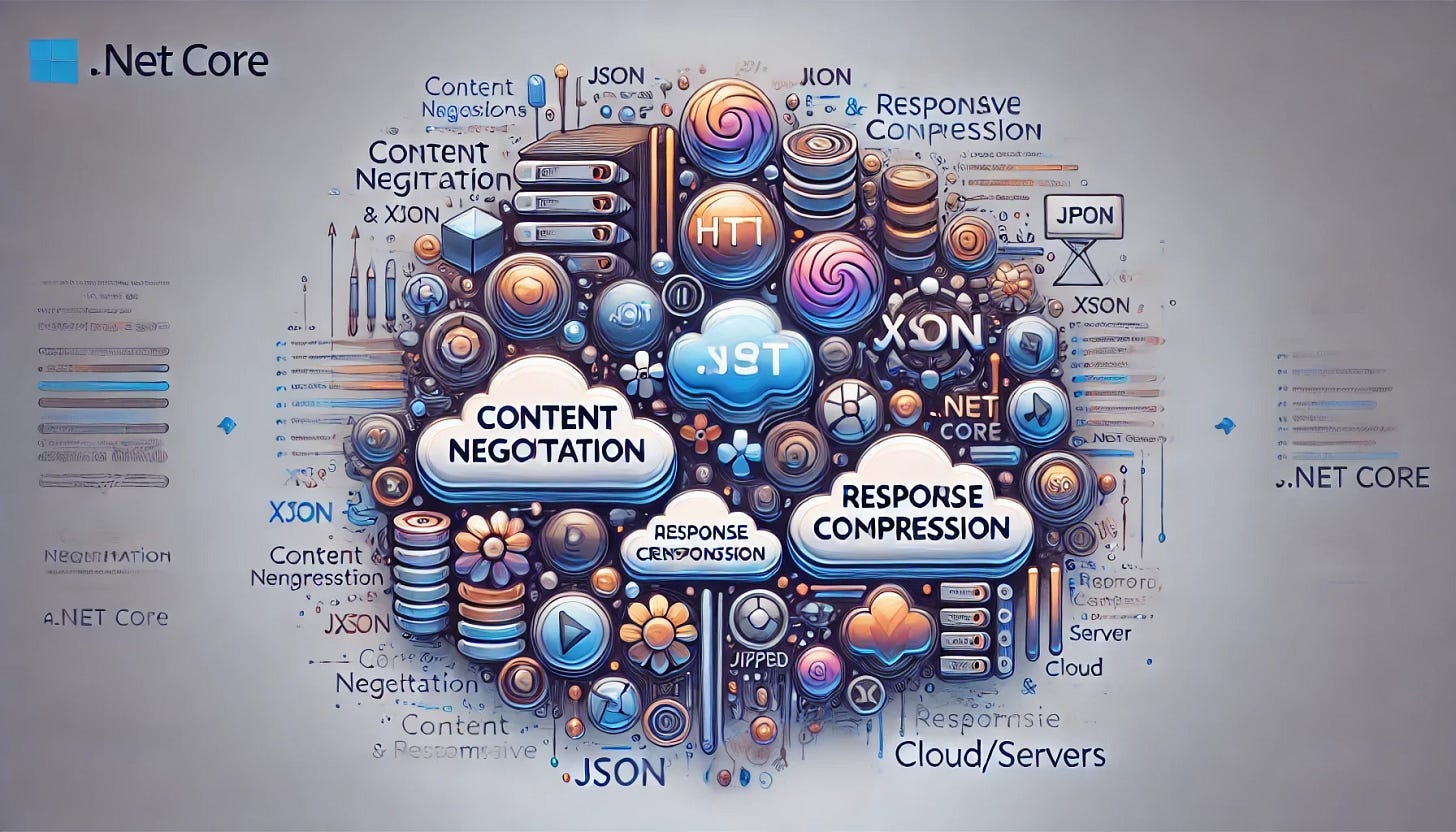Content Negotiation and Response Compression in .NET Core
Optimizing API Responses for Performance and Usability
In the world of web APIs, serving the right content efficiently is critical. Whether you're building APIs for mobile apps, web clients, or other services, delivering the correct format and minimizing response size can significantly improve performance and user experience. Content negotiation and response compression in .NET Core are powerful features that help you achieve this.
In this blog, we’ll explore:
Content Negotiation: What it is and how it works in .NET Core.
Response Compression: Why it’s important and how to implement it.
Best practices for combining these features to build efficient APIs.
1. What is Content Negotiation?
Content Negotiation is the process where the server determines the best response format (e.g., JSON, XML, or plain text) based on the client’s request.
Why is Content Negotiation Important?
Improved Flexibility: Clients can specify the desired format via HTTP headers.
Enhanced Interoperability: APIs can support multiple clients with different needs.
Customizability: Allows servers to return content tailored to specific requirements.
How Content Negotiation Works in .NET Core
In .NET Core, content negotiation is built into the ASP.NET Core MVC framework. The process is as follows:
The client sends an HTTP request with an
Acceptheader specifying the desired response format.The server checks the
Acceptheader and determines the best format.The server serializes the response accordingly.
Example: Accept Header
GET /api/products HTTP/1.1
Accept: application/json
Implementing Content Negotiation in .NET Core
Step 1: Configure Output Formatters
By default, .NET Core supports JSON responses, but you can add support for other formats like XML.
Add XML Formatter:
Install the
Microsoft.AspNetCore.Mvc.Formatters.Xmlpackage:dotnet add package Microsoft.AspNetCore.Mvc.Formatters.XmlUpdate
Program.cs:var builder = WebApplication.CreateBuilder(args); builder.Services.AddControllers() .AddXmlSerializerFormatters(); var app = builder.Build(); app.MapControllers(); app.Run();API Controller Example:
[ApiController] [Route("api/[controller]")] public class ProductsController : ControllerBase { [HttpGet] public IActionResult GetProducts() { var products = new List<Product> { new Product { Id = 1, Name = "Laptop", Price = 1200 }, new Product { Id = 2, Name = "Smartphone", Price = 800 } }; return Ok(products); } } public class Product { public int Id { get; set; } public string Name { get; set; } public decimal Price { get; set; } }
Step 2: Test with Different Formats
Request JSON:
GET /api/products HTTP/1.1 Accept: application/jsonResponse:
[ { "id": 1, "name": "Laptop", "price": 1200 }, { "id": 2, "name": "Smartphone", "price": 800 } ]Request XML:
GET /api/products HTTP/1.1 Accept: application/xmlResponse:
<ArrayOfProduct> <Product> <Id>1</Id> <Name>Laptop</Name> <Price>1200</Price> </Product> <Product> <Id>2</Id> <Name>Smartphone</Name> <Price>800</Price> </Product> </ArrayOfProduct>
2. What is Response Compression?
Response Compression reduces the size of the HTTP response sent from the server to the client, improving load times and reducing bandwidth usage.
👋 Become 1% better at .NET Full Stack development every day.
👆 https://dotnet-fullstack-dev.blogspot.com/
♻ Restack it Vibe matches, help others to get it
Why Use Response Compression?
Improved Performance: Faster response times, especially for large payloads.
Reduced Bandwidth Usage: Saves network resources, particularly for mobile clients.
Better User Experience: Quicker loading of content for end-users.
How Response Compression Works
When a client sends a request, it includes the Accept-Encoding header specifying supported compression algorithms (e.g., gzip, Brotli, deflate). If the server supports compression, it compresses the response using the specified algorithm.
Example: Accept-Encoding Header
GET /api/products HTTP/1.1
Accept-Encoding: gzip, deflate, br
Implementing Response Compression in .NET Core
Step 1: Add Response Compression Middleware
Install the
Microsoft.AspNetCore.ResponseCompressionpackage:dotnet add package Microsoft.AspNetCore.ResponseCompressionUpdate
Program.cs:var builder = WebApplication.CreateBuilder(args); builder.Services.AddResponseCompression(options => { options.EnableForHttps = true; options.Providers.Add<GzipCompressionProvider>(); options.Providers.Add<BrotliCompressionProvider>(); }); var app = builder.Build(); app.UseResponseCompression(); app.MapControllers(); app.Run();
Step 2: Configure Compression Providers
You can configure the compression level for each provider:
builder.Services.Configure<BrotliCompressionProviderOptions>(options =>
{
options.Level = System.IO.Compression.CompressionLevel.Optimal;
});
builder.Services.Configure<GzipCompressionProviderOptions>(options =>
{
options.Level = System.IO.Compression.CompressionLevel.Fastest;
});
Step 3: Test Response Compression
Use a tool like Postman or cURL to make requests with
Accept-Encodingheaders.Example:
curl -H "Accept-Encoding: gzip" http://localhost:5000/api/products --output compressed-response.gzInspect the compressed response. The server should return a smaller payload with the
Content-Encodingheader indicating the compression algorithm used.Response Headers:
Content-Encoding: gzip Content-Type: application/json
3. Best Practices for Content Negotiation and Response Compression
1. Use JSON as the Default Format
JSON is lightweight and widely supported, making it the best choice for most APIs. Add XML or other formats only when required.
2. Enable Compression for Large Responses
Compress responses for endpoints returning large payloads like file downloads, long lists, or reports.
3. Profile and Monitor API Performance
Use tools like Application Insights, Postman, or dotnet-counters to monitor response sizes and performance before and after enabling compression.
4. Avoid Overhead
While compression saves bandwidth, it introduces CPU overhead. Test and balance compression levels for optimal performance.
Conclusion
Content negotiation and response compression are essential features for building efficient APIs in .NET Core:
Content Negotiation ensures that your APIs are flexible and client-friendly by serving data in the requested format.
Response Compression reduces response sizes, improving load times and user experience.
By implementing these features and following best practices, you can deliver high-performing APIs that are both efficient and user-friendly.
Ready to optimize your APIs? Share your experiences or ask questions in the comments below!


